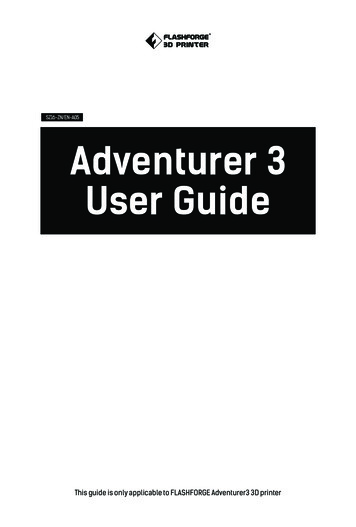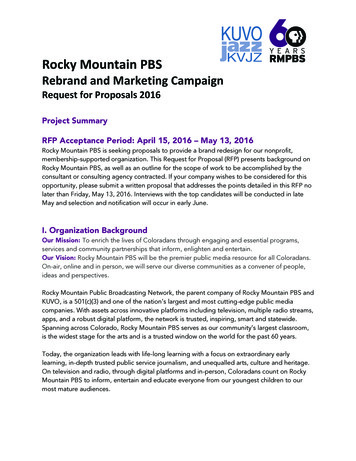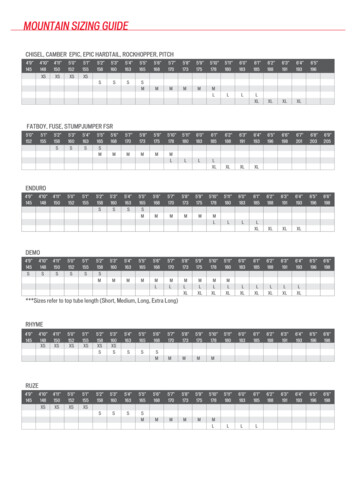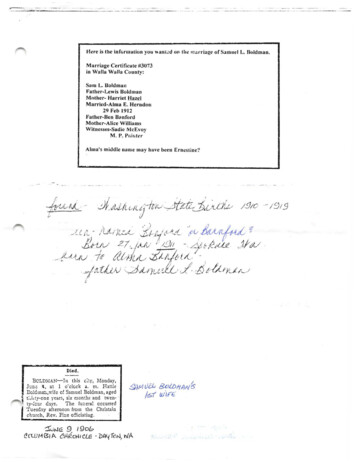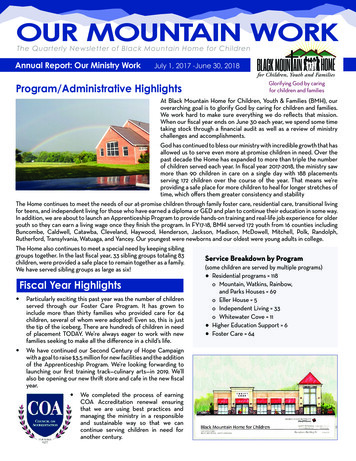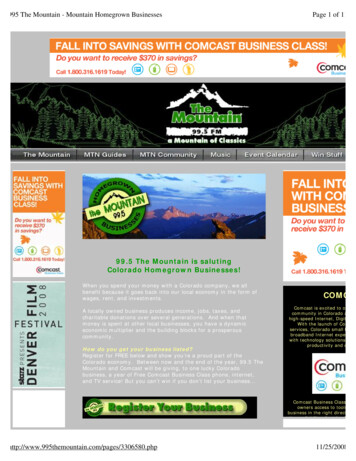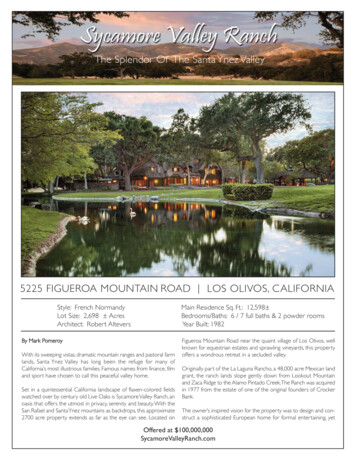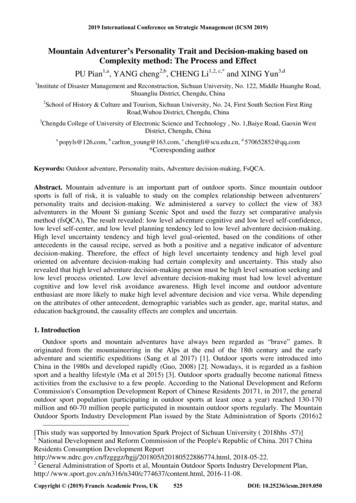
Transcription
2019 International Conference on Strategic Management (ICSM 2019)Mountain Adventurer’s Personality Trait and Decision-making based onComplexity method: The Process and EffectPU Pian1,a, YANG cheng2,b, CHENG Li1,2, c,* and XING Yun3,d1Institute of Disaster Management and Reconstruction, Sichuan University, No. 122, Middle Huanghe Road,Shuangliu District, Chengdu, China2School of History & Culture and Tourism, Sichuan University, No. 24, First South Section First RingRoad,Wuhou District, Chengdu, China3Chengdu College of University of Electronic Science and Technology , No. 1,Baiye Road, Gaoxin WestDistrict, Chengdu, Chinaapopyls@126.com, b carlton young@163.com, c chengli@scu.edu.cn, d 570652852@qq.com*Corresponding authorKeywords: Outdoor adventure, Personality traits, Adventure decision-making, FsQCA.Abstract. Mountain adventure is an important part of outdoor sports. Since mountain outdoorsports is full of risk, it is valuable to study on the complex relationship between adventurers’personality traits and decision-making. We administered a survey to collect the view of 383adventurers in the Mount Si guniang Scenic Spot and used the fuzzy set comparative analysismethod (fsQCA), The result revealed: low level adventure cognitive and low level self-confidence,low level self-center, and low level planning tendency led to low level adventure decision-making.High level uncertainty tendency and high level goal-oriented, based on the conditions of otherantecedents in the causal recipe, served as both a positive and a negative indicator of adventuredecision-making. Therefore, the effect of high level uncertainty tendency and high level goaloriented on adventure decision-making had certain complexity and uncertainty. This study alsorevealed that high level adventure decision-making person must be high level sensation seeking andlow level process oriented. Low level adventure decision-making must had low level adventurecognitive and low level risk avoidance awareness. High level income and outdoor adventureenthusiast are more likely to make high level adventure decision and vice versa. While dependingon the attributes of other antecedent, demographic variables such as gender, age, marital status, andeducation background, the causality effects are complex and uncertain.1. IntroductionOutdoor sports and mountain adventures have always been regarded as “brave” games. Itoriginated from the mountaineering in the Alps at the end of the 18th century and the earlyadventure and scientific expeditions (Sang et al 2017) [1]. Outdoor sports were introduced intoChina in the 1980s and developed rapidly (Guo, 2008) [2]. Nowadays, it is regarded as a fashionsport and a healthy lifestyle (Ma et al 2015) [3]. Outdoor sports gradually become national fitnessactivities from the exclusive to a few people. According to the National Development and ReformCommission's Consumption Development Report of Chinese Residents 20171, in 2017, the generaloutdoor sport population (participating in outdoor sports at least once a year) reached 130-170million and 60-70 million people participated in mountain outdoor sports regularly. The MountainOutdoor Sports Industry Development Plan issued by the State Administration of Sports (2016)2[This study was supported by Innovation Spark Project of Sichuan University ( 2018hhs -57)]1National Development and Reform Commission of the People's Republic of China. 2017 ChinaResidents Consumption Development 0180522886774.html, 2018-05-22.2General Administration of Sports et al, Mountain Outdoor Sports Industry Development Plan,http:/ /www.sport.gov.cn/n316/n340/c774637/content.html, 2016-11-08.Copyright (2019) Francis Academic Press, UK525DOI: 10.25236/icsm.2019.050
aims to achieve a total scale of 400 billion RMB by 2020. Behind the rapid development of theindustry, accidents were happened frequently in the outdoor sports, like mountaineering, with 70deaths in 2017 and 63 deaths in 2016, which were the same as the highest mortality rate in 2014 and44 deaths in 20153. This problem are affecting sustainable development of mountain outdoor sports.Nowadays, China scholars mainly focus on five core areas likes outdoor specialty, outdoorrecreation, outdoor education, outdoor competition, outdoor adventure (Song et al, 2018)[4] fromthe “competitiveness” and “safety” perspective(Guo; Song et al, 2018)[2,4].The specific outdooradventure research mostly focuses on the summary the inspiration of international research (Ma etal.,2015[3]) International researchers focus on outdoor sport or adventure from psychology(Zuckerman, 1979; Jack & Ronan, 1998; Figner & Weber, 2015) [5-7]; sociology (Butler,2019)[8];management (Buckley, 2007)[9] perspective to conduct multi-perspective research, involvingpersonality (Figner&Weber,2015; Tsung et al,2015)[7][10] motivation (Pomfret, 2006) [11],behavior and satisfaction (Tsung et al, 2015) [10], The impact of adventure tourism on the naturalenvironment and cultural norms of destination (Nehal,2008; Pope,2018)[12], risk prevention andsafety management of adventure activities (Bentley, 2008; Nwankwo et al,2018)[13-14] .Therefore,this paper will focus on the mountain adventure 'personality traits and adventure decision-making.Since mountain outdoor sports full of risks, adventurers would face the risks of hypoxia,hypothermia, slipping, falling, mountain torrents, Alpine disease (Bentley, 2008)[13], while thosemountain adventurers usually has a high adventure cognitive; sensation seeking (Zuckerman, 1979);Pomfret, 2006)[5][11]; Self-confidence (Dann,1977; Pomfret, 2006; Qiu, 2005)[11][15]; SelfCenter (Cheng&Luo, 2016)[16] and other personality traits. And also repents process-oriented orgoal-oriented (Pomfret, 2006)[11], planning tendency and uncertainty tendency (Cheng& Luo, 2016)[16], strong and weak Adventure risk avoidance consciousness (Tok, 2011)[17] behaviorcharacteristic etc. Therefore, the mountain outdoor adventure decision-making is highly complex,but most of the research were based on simple linear interaction (Tok, 2011[17]; Tsung et al,2015[10]; McEwan et al, 2019[18]). This paper will explore the personality trait and mountainoutdoor adventure decision-making from the perspective of complexity theory, and try to revealintrinsic logic of the complex relationship between the personality traits and adventure decisionmaking behavior, that has great practical significance to the sustainable development of mountainoutdoor sports.2. Literature Review2.1.Personality Traits and Behaviour CharacteristicsPersonality, is a relatively sTable psychological characteristic formed by long-term developmentof individuals (Figner& Weber, 2015) [7]. Personality is closely related to behaviour, and personalityinfluences behaviour. Behaviour is the reflection of personality trait. People with differentpersonalities also shows different characteristics in their adventure decision-making behaviour.Generally, personality is considered to be an important factor in people's participation in riskysports (Jack & Ronan, 1998) [6] . As early as 1960, Berlyne believed that everyone had their ownoptimal stimulation level (OSL), while people with low OSL did not tend to choose risky activitiessuch as mountaineering, skydiving, cross-continental travel or vice versa (Weber, 2001).Zuckerman (1979) believed that “sensation seeking as seeking of varied, novel, complex andintense sensations experiences and the willingness to take physical, social, legal and financial risksfor sake of such experiences”. Researchers had also revised four-factor structure of “sensationseeking”. Thrill and adventure seeking, experience seeking, disinhibition, boredom susceptibility(Zuckerman, 1979, 1994; Pomfret, 2011) [5] [11]. Zuckerman (1979) further studies found that peoplewho was sensation seeker, tend to choose jobs involving high levels of change, flexibility and 015-05-25/471067.html,2018-7-13.526Platform.
kind of risks [5]. In addition, Dann (1977) explained travel behaviour with push-pull theory,believing that self-confidence was the driving factor of decision-making like escape, socialrecognition and sociality. Self-confidence also affected travel decision-making (Qiu, 2005) [15].Pomfret (2016) further believed that self-confidence was the driving factor of mountaineering. Inaddition, self-center (Cheng& Luo, 2016) were also considered to an important personality trait ofadventurers. In addition, as a risky outdoor sport, Pomfret (2006) [11] confirmed that adventurecognitive influences the adventure decision-making, with higher the individual's adventurecognitive, the more inclined to choose the adventure behaviour. Scholars had proposed thatmountain adventurers who were process oriented paying attention to excitement and pleasure in theprocess. And “goal oriented” were (Pomfret, 2006) [11] seeking goal achievement and recognition(Cheng& Luo, 2016 [16]), McEwan et al, 2019 [18] confirmed that personality trait and goal orientedsignificantly affect the participation of high-risk sports. Cheng and Luo (2016) [16] further proposedthat adventurer 'behavior characteristic could be divided into “planning tendency” and “uncertaintytendency”. As a high-risk sport, risk avoidance consciousness also affects adventure decisionmaking. Tok (2011) indicated that extroverted, open, low level risk avoidance consciousness peoplewere more willing to participate in risk sport. Therefore, this paper studied the adventure cognitive,sensation seeking, self-confidence, self-center, risk avoidance consciousness, goal oriented orprocess oriented, planning tendency or uncertainty tendency as the “causal” of adventure decisionmaking.2.2.Adventure Decision-makingDecision-making refers to participants evaluated relevant alternatives and made their final choice(Carroll & Johnson, 1990)[19].It mostly discussed from Expected Utility Theory, Prospect Theory,Regret Theory, Satisfaction Theory and Planning Behaviour Theory. In tourism research, decisionmaking is usually influenced by internal and external factors such as environment, risk preference,psychological, economic condition, group support, gender, personality trait and so on (Qiu et al,2004)[20], in which personality trait is important factor for decision-making (Carroll & Johnson,1990; Tok, 2011)[17] [19]. Tsung et al (2015)[10] research on white water rafting and scuba diving,introverted and open personality trait significantly affected risk-taking attitude, while risk-takingattitude significantly affected adventure behaviour. McEwan et al (2019)[18] considered thatsensation seeking, extroversion and impulse had significant effects on high-risk sports participation.Pomfret (2018)[21] believed that skills development, seeking experience, close to natural, challenges,risks, sensation seeking and achievement and experiencing flow and increasing collective efficacywere also driving factors for adventure. Pomfret (2012)[22] showed that packaged mountaineeringpeople decisions-making was related to risk perception. In addition, such as social advocacy andpromoting of certain behaviours, as well as the behaviour of individual reference groups, whichplay an important role in decision-making, while economic factors become the basic constraints ofdecision-making (Qiu&Wu,2004)[20]. For gender, women were more sensitive to social environmentand group attitudes in decision-making, while men were more susceptible to landscape (Qin&Lin,2014)[23].2.3.Complexity TheoryComplexity theory is used to explain the non-linear and dynamic process of complex phenomenain various disciplines. It is based on Boolean algebra, Consistency and Coverage are used asindicators in asymmetric analysis. Consistency index gauges the degree to which the cases share asimple or complex condition in displaying the outcome in question. The coverage index assesses thedegree to which a simple and complex causal condition (Woodside, 2014)[24]. Olya (2018)[25] andother scholars were applied to sub-disciplines of management, such as marketing and tourism. Thestudy assessed the model results according to the complexity theory to understand the complexinteractions of personality traits and behaviour characteristics in mountain outdoor sports andadventure decision-making.527
Figure 1 Proposed Model.The proposed model consists of two parts (Figure 1). The causal configuration of the personalitytraits and behaviour characteristics antecedents of predicting adventure decision-making is indicatedwith model A, demographic variables antecedent of predicting adventure decision-making isindicated with model B. The outcomes represents under which circumstances, people participate inthe adventure outdoor sports again and recommend to friends and others.3. Methodology3.1.Research processSPSS 25.0, Smart PLS 2.0 and fsQCA 3.0 were used to analyse data, reliability were checkedwith SPSS25.0 in the first step. Then Smart PLS 2.0 was used to check the composite reliability andconstruct validity. In the second step, standard deviations, correlation, and cross-tabulation of thevariables were calculated using SPSS25.0. In the third step, fsQCA3.0 software were applied forpredicting high and low score for adventure decision-making outcomes.3.2.Measurement instrumentsBased on the mountain adventure decision-making model proposed by Cheng and Luo (2016),and the scale items were derived from relevant literature and modified based on the suggestion ofexperts. The responses to all items were on a five-point Liker scale ranging from1 stronglydisagree to5 strongly agree. The questionnaire consisted of two sections. The first exploredpersonality traits, behavioural characteristic and decision-making. While the second capturedrespondents’ profiles and behavioural variables (frequency, duration, mode of travel, etc.)3.3.Data and procedure
this paper will focus on the mountain adventure 'personality traits and adventure decision-making. Since mountain outdoor sports full of risks, adventurers would face the risks of hypoxia, hypothermia, slipping, falling, mountain torrents, Alpine disease Bentley( , 2008)[13], while those
